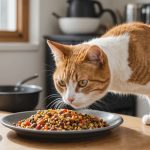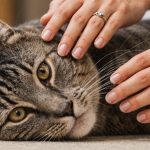Understanding Gastric Torsion and Its Impact on Deep-Chested Breeds
Recognising the symptoms of gastric torsion, or “bloat,” is crucial for anyone caring for deep-chested dog breeds like Weimaraners. Gastric torsion occurs when a dog’s stomach fills with gas and then twists, causing a life-threatening condition. This distorts the blood supply to vital organs, leading to potential tissue death if not addressed promptly.
Deep-chested breeds, such as Weimaraners, are particularly vulnerable to gastric torsion due to their physiological structure. Their deep and narrow chest cavity allows the stomach more freedom to move, increasing the likelihood of it flipping over. Prevention strategies include feeding smaller, more frequent meals and avoiding vigorous exercise immediately after eating.
Lire également : Effective Strategies to Teach Your Gordon Setter to Walk Calmly on a Leash
The consequences of delayed treatment for gastric torsion can be severe. Symptoms typically include a swollen abdomen, unproductive retching, and signs of distress such as panting and restlessness. Immediate veterinary intervention is essential to correct the twist and relieve pressure. Left untreated, gastric torsion can result in shock, organ failure, or death within hours. Owners of deep-chested breeds should be aware of these risks and act quickly if they suspect their pet is experiencing bloat. Understanding these essential factors empowers pet owners to safeguard the health of their Weimaraners and other deep-chested companions.
Dietary Recommendations to Mitigate Risk
To safeguard your dog’s health and well-being, adopting effective feeding strategies is key. Selecting the appropriate dog nutrition is an essential aspect of preventing bloat and other digestive issues.
Cela peut vous intéresser : Effective Strategies to Address Food Guarding in Your Possessive Rottweiler
Types of Food to Consider
Choosing the right dog nutrition involves selecting high-quality, easily digestible foods that cater to your pet’s unique dietary requirements. Opt for foods that list animal protein as the first ingredient, as they usually provide better quality nutrition. Additionally, consider avoiding excessive fat and low-quality fillers, which may contribute to digestive discomfort and bloating.
Feeding Frequency and Portion Control
Adjusting feeding strategies focuses on portion control and frequency. Feeding your pup smaller, more frequent meals throughout the day can help in reducing bloat risk by ensuring the stomach is never overly full. Avoid exercising your pet immediately after meals to further minimize this risk. Implementing scheduled feeding times can aid in digestion and promote a sense of routine for your dog.
Importance of Water Intake
Maintaining proper hydration plays a crucial role in your dog’s digestive health. Ensure constant availability of clean, fresh water, as it aids in the breakdown and absorption of nutrients. Hydration also facilitates smoother digestion, reducing the likelihood of gastric distress and promoting overall well-being in your four-legged friend.
Safe Feeding Practices
Ensuring safe feeding practices is essential for a dog’s well-being and health. Slow feeders are an excellent tool to prevent rapid eating, a common issue that can lead to digestive problems and bloating in dogs. These feeders are designed with obstacles in the interior, forcing dogs to eat more slowly and chew their food properly, promoting better digestion.
In addition, the dog’s posture during feeding is crucial. Elevating food bowls can encourage a healthier feeding position, especially for larger breeds, reducing the strain on their neck and back. Proper alignment while eating aids in easier swallowing and may also help reduce the risk of bloat.
Monitoring for food-related anxiety is another critical component of safe feeding practices. Anxiety during mealtime can cause a dog to eat too quickly or skip meals altogether. Observe your furry friend for signs such as restlessness or excessive drooling. It may be necessary to create a calmer environment or introduce new feeding strategies, such as using slow feeders or altering their feeding routine, to mitigate anxiety.
Overall, paying attention to your dog’s feeding habits and environment ensures they benefit from their meals while maintaining optimal health.
Exercise Routines and Activities
When considering exercise guidelines for Weimaraners, it is crucial to understand their unique needs as a deep-chested breed. This trait makes them particularly susceptible to bloat, so careful planning of exercise is vital.
Recommended Activities Before Meals
Before meals, focus on gentle activities to prepare your Weimaraner for more intensive post-meal exercise. Activities such as short walks or calm play sessions are advisable, ensuring your pet remains relaxed yet energized.
Post-Meal Exercise Guidelines
Post-meal activities require cautious management. It is recommended to wait at least 1 to 2 hours after a meal before engaging in any rigorous exercise. This timing allows for proper digestion, reducing the risk of complications like bloat. Instead, opt for low-intensity activities such as relaxed walks to promote digestion without stress.
Recognizing Signs of Discomfort
Watch for warning signs of bloat or discomfort during or after exercise. Key indicators include restlessness, excessive drooling, or a swollen abdomen. Immediate action and consultation with a veterinarian are essential if these symptoms occur.
By following these exercise routines and paying careful attention to your Weimaraner’s behaviour, you can help ensure they remain healthy and happy, minimizing the risk associated with their deep-chested breed structure.
Expert Opinions and Case Studies
With detailed insights from seasoned professionals, the veterinary insights on gastric torsion prevention emphasize the importance of early diagnosis and proactive management. Veterinarians advocate for several key strategies aimed at reducing the risk of this serious condition. Regular monitoring of eating habits and scheduling consistent feeding times are commonly recommended methods. These strategies promote not only digestive health but also overall well-being.
Case Studies and Analysis
Several case studies underscore the effectiveness of these preventive measures. For instance, one documented case involves a large breed dog which began a new regimen of smaller, more frequent meals, combined with limited exercise post-feeding. This allowed for better digestion and significant risk reduction in gastric torsion occurrences. Over a six-month period, the dog’s health was monitored, and results showed a notable decrease in symptoms commonly associated with gastric distress.
Insight from Breeders
Breeders also contribute invaluable experiences and insights into preventative practices. They suggest the implementation of specific dietary adjustments and close observation of high-risk breeds to curb the onset of symptoms. Breeders’ recommendations are often aligned with veterinary suggestions, providing a unified approach to managing this condition. By incorporating shared knowledge, both veterinary and breeder recommendations create a holistic care strategy for dogs at risk of gastric torsion.
Medical Interventions and Preventive Options
In addressing the complexities of gastric torsion, a multifaceted approach incorporating both medical interventions and prevention techniques is essential.
Surgical Options for High-Risk Breeds
For high-risk dog breeds, surgical intervention, such as a prophylactic gastropexy, is often considered. This procedure involves surgically attaching the stomach to the abdominal wall, significantly reducing the risk of torsion. Particularly beneficial for breeds predisposed to gastric torsion, this preemptive surgery can be life-saving, offering long-term protection against this life-threatening condition.
Importance of Regular Veterinary Check-ups
Routine veterinary check-ups play a crucial role in maintaining your pet’s health. Regular visits not only ensure ongoing monitoring of any emerging health issues but are also paramount in implementing effective prevention techniques. These examinations allow veterinarians to assess any internal changes and advise on dietary or lifestyle modifications to decrease the risk of complications like gastric torsion.
Monitoring For Genetic Predispositions
Understanding and monitoring genetic predispositions is vital, especially in deep-chested breeds prone to gastric complications. Identifying if your breed has a genetic inclination towards such disorders can guide proactive measures. Enhanced vigilance, informed dietary choices, and the possible consideration of preventive surgical measures contribute toward managing these risks effectively.
Actionable Tips for Pet Owners
When it comes to ensuring the well-being of your furry friend, practical tips can make all the difference. Implementing easy-to-follow strategies as a pet owner can help prevent various health issues and enhance your pet’s overall quality of life.
Begin by establishing a consistent routine, which can be reassuring and comforting for your dog. Regular meal times and scheduled physical activities contribute to a stable environment. For example, feeding smaller, more frequent meals can be an effective way to adhere to bloat prevention practices. Adjusting the feeding area to reduce the amount of air your pet inhales can lower the risk of bloat, a concern for many large dog breeds.
Creating a supportive environment goes beyond just physical care. It involves emotional and social engagement too. Encouraging social interactions with other dogs can keep your pet mentally stimulated and reduce anxiety.
Building connections with a community of dog owners presents invaluable opportunities to share knowledge and experiences. By exchanging pet owner advice, you can discover new techniques to support your dog’s happiness and health. Participation in local pet meet-ups or online forums can provide practical insights and foster close-knit friendships, benefiting both you and your pet.
Embrace these tips for a healthier, happier pet.











